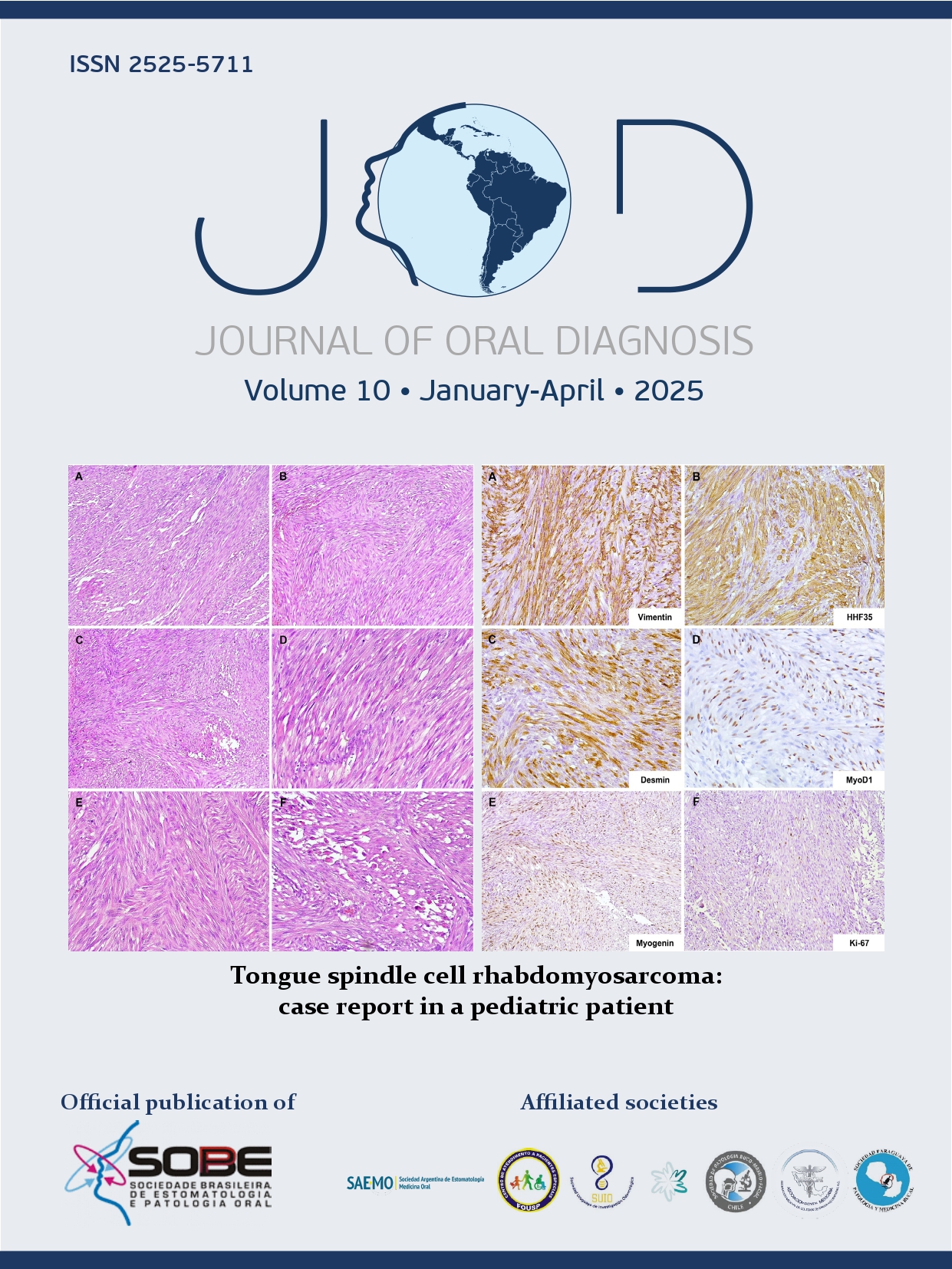Oral squamous cell carcinoma adjacent to dental implant: a case report with a long-term follow-up
DOI:
https://doi.org/10.5327/2525-5711.267Palavras-chave:
Oral squamous cell carcinoma, Dental implants, Oral Cancer, Oral PathologyResumo
Head and neck cancers are a growing global health concern, with oral squamous cell carcinoma (OSCC) accounting for 90-95% of all cases within this region. OSCC near dental implants can resemble benign inflammatory lesions, posing diagnosis challenging. A 74-year-old man presented with an ulcerated, asymptomatic lesion in the upper right alveolar mucosa, initially misdiagnosed as a benign inflammatory condition due to its proximity to a dental implant. Afterwards the lesion was identified as OSCC, and the patient underwent surgical treatment. Three years post-surgery, a white plaque appeared near the grafted area and was diagnosed as oral leukoplakia. Although, over the course of fourteen years, the patient had no recurrences or metastases. Therefore, clinicians should be aware that while most lesions around dental implants are of inflammatory origin, OSCC must be considered in differential diagnosis in cases that do not respond to standard treatments.
Referências
Badwelan M, Muaddi H, Ahmed A, Lee KT, Tran SD.
Oral squamous cell carcinoma and concomitant primary
tumors, what do we know? A review of the literature.
Curr Oncol. 2023;30(4):3721-34. https://doi.org/10.3390/
curroncol30040283
Varsha BK, Radhika MB, Makarla S, Kuriakose MA, Kiran
GS, Padmalatha GV. Perineural invasion in oral squamous
cell carcinoma: case series and review of literature. J
Oral Maxillofac Pathol. 2015;19(3):335-41. https://doi.
org/10.4103/0973-029X.174630
Mello FW, Melo G, Pasetto JJ, Silva CAB, Warnakulasuriya
S, Rivero ERC. The synergistic effect of tobacco and alcohol
consumption on oral squamous cell carcinoma: a systematic
review and meta-analysis. Clin Oral Investig. 2019;23(7):2849-
https://doi.org/10.1007/s00784-019-02958-1
Ghantous Y, Schussel JL, Brait M. Tobacco and alcoholinduced
epigenetic changes in oral carcinoma. Curr
Opin Oncol. 2018;30(3):152-8. https://doi.org/10.1097/
CCO.0000000000000444
Ali J, Sabiha B, Jan HU, Haider SA, Khan AA, Ali SS. Genetic
etiology of oral cancer. Oral Oncol. 2017;70:23-8. https://doi.
org/10.1016/j.oraloncology.2017.05.004
Irimie AI, Ciocan C, Gulei D, Mehterov N, Atanasov AG, Dudea
D, et al. Current insights into oral cancer epigenetics. Int J
Mol Sci. 2018;19(3):670. https://doi.org/10.3390/ijms19030670
Badwelan M, Muaddi H, Ahmed A, Lee KT, Tran SD. Oral
squamous cell carcinoma and concomitant primary tumors,
what do we know? A review of the literature. Curr Oncol.
;30(4):3721-34. https://doi.org/10.3390/curroncol30040283
Pires FR, Ramos AB, Oliveira JBC, Tavares AS, Luz PS, Santos
TCRB. Oral squamous cell carcinoma: clinicopathological
features from 346 cases from a single oral pathology service
during an 8-year period. J Appl Oral Sci. 2013;21(5):460-7.
https://doi.org/10.1590/1679-775720130317
Chi AC. Epithelial pathology – squamous cell carcinoma. In:
Neville BW, Damm DD, Allen CM, Chi AC, editors. Oral &
maxillofacial pathology. 4th ed. Philadelphia: WB Saunders;
p. 374-89.
Raiser V, Abu-El Naaj I, Shlomi B, Fliss DM, Kaplan I. Primary
oral malignancy imitating peri-implantitis. J Oral Maxillofac Surg.
;74(7):1383-90. https://doi.org/10.1016/j.joms.2016.02.008
Galvis MM, Faustino ISP, Ramos JC, Silva ARS, Alves FA,
Kowalski LP, et al. Oral cancer adjacent to dental implants
mimicking benign lesions: a case series study. Aust Dent J.
;66(1):112-8. https://doi.org/10.1111/adj.12793
International Agency for Research on Cancer. World Health
Organization. Cancer today. Data visualization tools for
exploring the global cancer burden in 2022 [accessed Jan.
, 2023]. Available from: https://gco.iarc.fr/today
Louredo BVR, Curado MP, Penafort PVM, Arruda JAA,
Abreu LG, Mesquita RA, et al. Contribution of public oral
pathology services to the diagnosis of oral and oropharyngeal
cancer in Brazil. Braz Oral Res. 2023;37:e126. https://doi.
org/10.1590/1807-3107bor-2023.vol37.0126
Lorini L, Atín CB, Thavaraj S, Müller-Richter U, Ferranti MA,
Romero JP, et al. Overview of oral potentially malignant
disorders: from risk factors to specific therapies. Cancers (Basel).
;13(15):3696. https://doi.org/10.3390/cancers13153696
Piemonte ED, Gilligan GM, Garola F, Lazos JP, Panico RL,
Normando AGC, et al. Differences among oral carcinomas
arising de novo from those associated with oral potentially
malignant disorders: a systematic review and meta-analysis.
Oral Surg Oral Med Oral Pathol Oral Radiol. 2024;137(6):613-
https://doi.org/10.1016/j.oooo.2024.03.006
Gilligan G, Panico R, Lazos J, Morelatto R, Belardinelli P,
Criscuolo MI, et al. Oral squamous cell carcinomas and oral
potentially malignant disorders: a Latin American study. Oral
Dis. 2024;30(5):2965-84. https://doi.org/10.1111/odi.14778
Bharanidharan R, Dineshkumar T, Raghavendhar K, Kumar
AR. Squamous cell carcinoma of the gingiva: a diagnostic
enigma. J Oral Maxillofac Pathol. 2015;19(2):267. https://doi.
org/10.4103/0973-029X.164558
Ramos JC, Alves FA, Kowalski LP, Dos Santos-Silva AR,
Vargas PA, Lopes MA. Epidemiological profile and clinical
implications of oral squamous cell carcinoma adjacent to
dental implants. Oral Dis. 2021;27(7):1687-98. https://doi.
org/10.1111/odi.13710
Ortiz AJ, Fernández E, Vicente A, Calvo JL, Ortiz C. Metallic
ions released from stainless steel, nickel-free, and titanium
orthodontic alloys: toxicity and DNA damage. Am J Orthod
Dentofacial Orthop. 2011;140(3):e115-22. https://doi.
org/10.1016/j.ajodo.2011.02.021
Guillaume B. Dental implants: a review. Morphologie.
;100(331):189-98. https://doi.org/10.1016/j.
morpho.2016.02.00
Schache A, Thavaraj S, Kalavrezos N. Osseointegrated implants:
a potential route of entry for squamous cell carcinoma of the
mandible. Br J Oral Maxillofac Surg. 2008;46(5):397-9. https://
doi.org/10.1016/j.bjoms.2007.09.009
Ramos JC, Dos Santos ES, Normando AGC, Alves FA, Kowalski
LP, Santos-Silva AR, et al. Oral squamous cell carcinoma
around dental implants: a systematic review. Oral Surg Oral
Med Oral Pathol Oral Radiol. 2021;131(6):660-74. https://doi.
org/10.1016/j.oooo.2021.01.019
Del Amo FSL, Rudek I, Wagner VP, Martins MD, O’Valle F,
Galindo-Moreno P, et al. Titanium activates the DNA damage
response pathway in oral epithelial cells: a pilot study. Int
J Oral Maxillofac Implants. 2017;32(6):1413-20. https://doi.
org/10.11607/jomi.6077
Kullar AS, Miller CS. Are there contraindications for placing
dental implants? Dent Clin North Am. 2019;63(3):345-62.
https://doi.org/10.1016/j.cden.2019.02.004
Peralta-Mamani M, Terrero-Pérez Á, Tucunduva
RMA, Rubira CMF, Santos PSS, Honório HM, et al.
Occurrence of field cancerization in clinically normal
oral mucosa: a systematic review and meta-analysis. Arch
Oral Biol. 2022;143:105544. https://doi.org/10.1016/j.
archoralbio.2022.105544
Dakubo GD, Jakupciak JP, Birch-Machin MA, Parr RL. Clinical
implications and utility of field cancerization. Cancer Cell Int.
;7:2. https://doi.org/10.1186/1475-2867-7-2
Bark R, Mercke C, Munck-Wikland E, Wisniewski NA,
Hammarstedt-Nordenvall L. Cancer of the gingiva. Eur
Arch Otorhinolaryngol. 2016;273(6):1335-45. https://doi.
org/10.1007/s00405-015-3516-x
Arduino PG, Carbone M, Gambino A, Cabras M, Cannarsa
F, Macciotta A, et al. Challenging management of gingival
squamous cell carcinoma: a 10 years single-center retrospective
study on Northern-Italian patients. Med Oral Patol Oral
Cir Bucal. 2021;26(1):e21-e27. https://doi.org/10.4317/
medoral.23913
Sim YC, Hwang JH, Ahn KM. Overall and disease-specific
survival outcomes following primary surgery for oral
squamous cell carcinoma: analysis of consecutive 67 patients.
J Korean Assoc Oral Maxillofac Surg. 2019;45(2):83-90. https://
doi.org/10.5125/jkaoms.2019.45.2.83
Downloads
Publicado
Como Citar
Edição
Seção
Licença
Copyright (c) 2024 Marco Túlio Leandro Ribeiro, Fabio Ramoa Pires, Rogerio de Andrade Elias, Fábio de Abreu Alves , Alan Roger dos Santos-Silva , Pablo Agustin Vargas, Luiz Paulo Kowalski, Marcio Ajudarte Lopes

Este trabalho está licenciado sob uma licença Creative Commons Attribution 4.0 International License.














